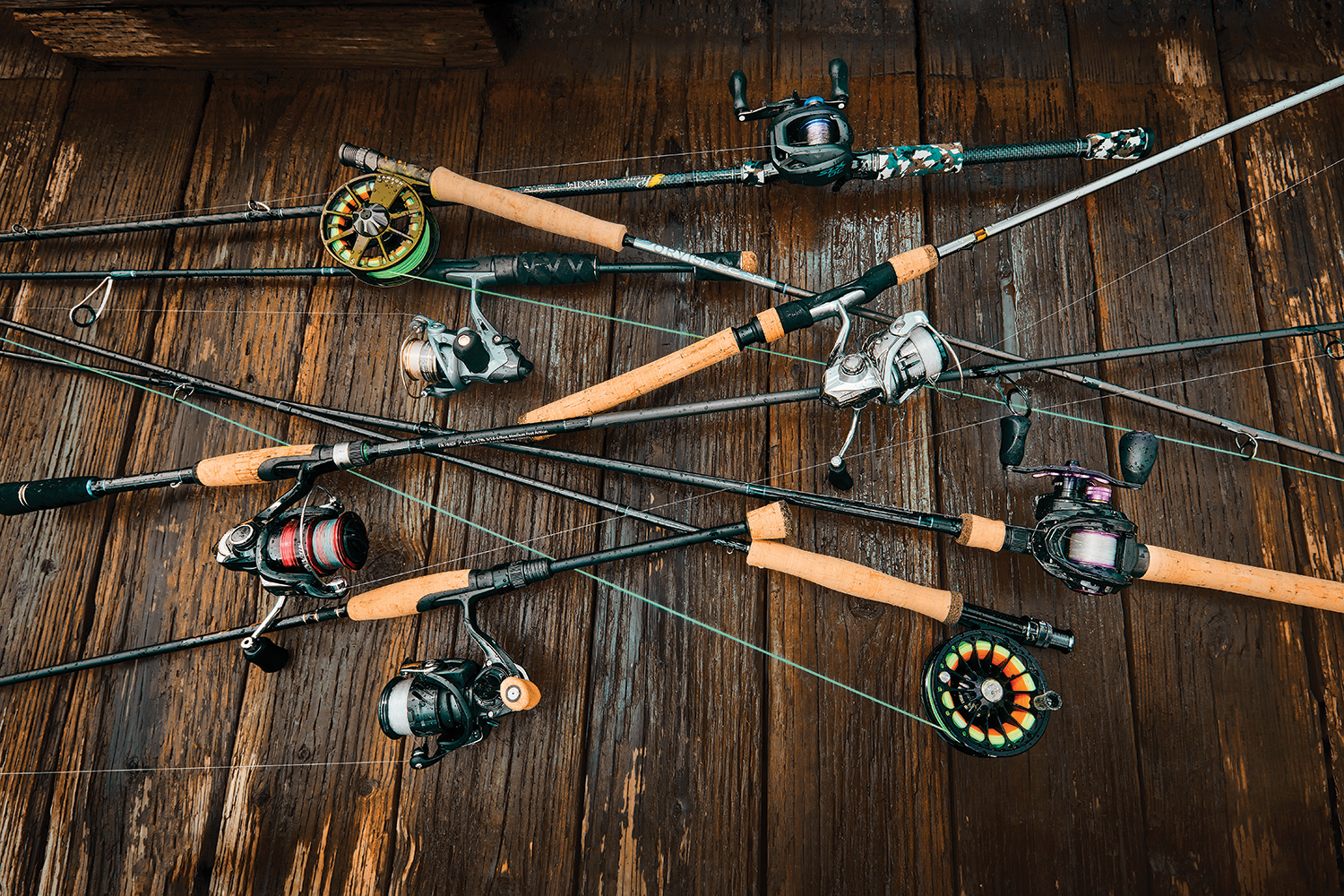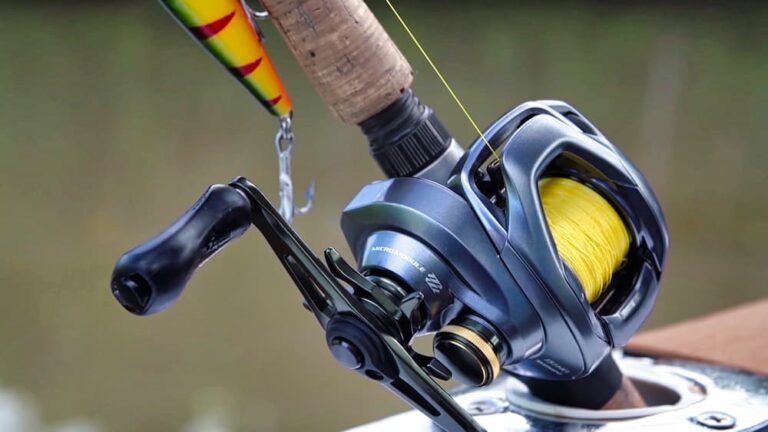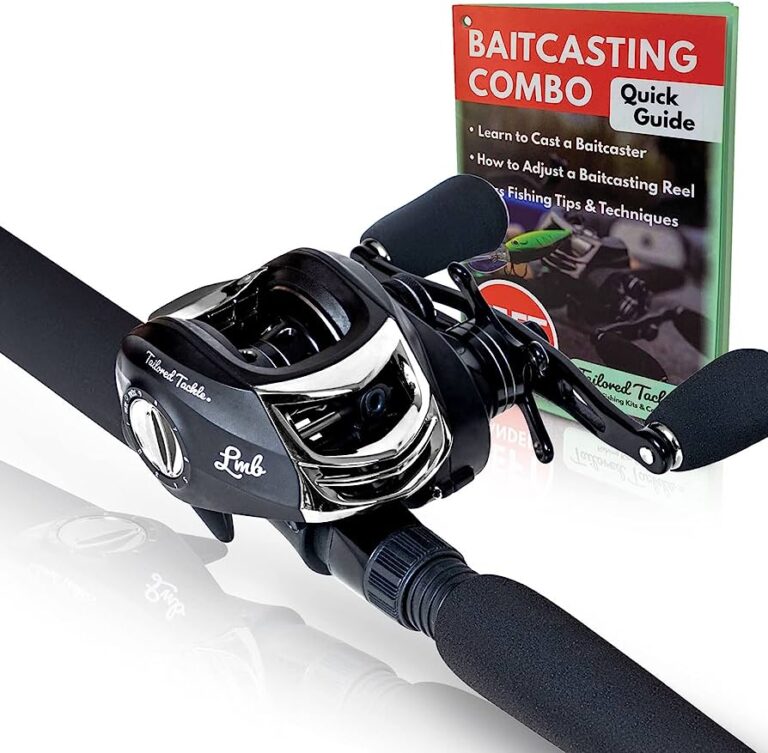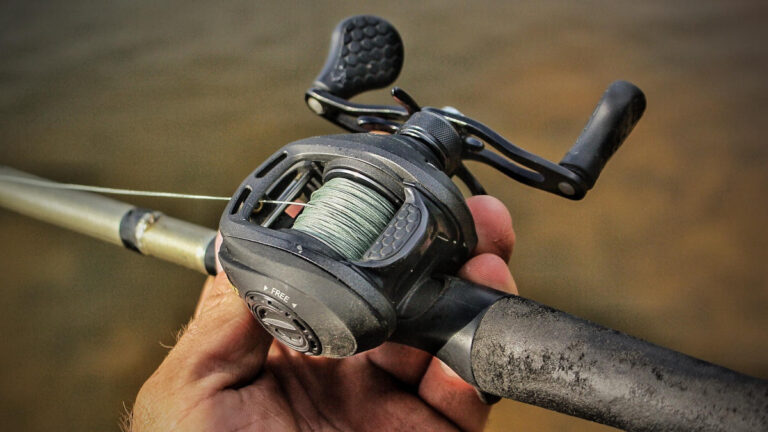To use a baitcasting rod and reel, first, set the spool tension according to the weight of your lure. Then, adjust the brake system to avoid backlashes while casting.
When using a baitcasting rod and reel, it’s important to follow a few steps to ensure smooth and effective fishing. The first step is to set the spool tension, which determines how freely the line comes off the spool. This should be adjusted according to the weight of your lure.
Next, adjust the brake system to control the rotational speed of the spool during casting, preventing backlashes. Having the right combination of spool tension and brake setting will help you achieve accurate and long-distance casts. With practice, you’ll become skilled at using a baitcasting rod and reel for catching fish effectively.

Credit: www.outdoorlife.com
Understanding The Basics Of Baitcasting Gear
Baitcasting gear is a popular choice among anglers who are looking for a versatile and powerful fishing setup. However, it can be a little tricky to master if you’re new to using a baitcasting rod and reel. In this section, we’ll explore the advantages and disadvantages of baitcasting gear, discuss how to choose the right baitcasting rod and reel combo, and familiarize ourselves with some common baitcasting terminology.
The Advantages And Disadvantages Of Baitcasting Gear
Advantages:
- Greater casting distance: Baitcasting gear allows for longer and more accurate casts, making it ideal for targeting fish that are far away or in tight spots.
- Increased accuracy and control: With practice, anglers can achieve precise lure placement and better control over their bait, enhancing the chances of a successful catch.
- Ideal for heavy lures and line: Baitcasting reels are designed to handle heavier lures and lines compared to spinning reels, making them suitable for tackling larger fish species.
- Power and strength: Baitcasting rods are typically more robust and offer more power, allowing anglers to handle bigger fish and challenging fishing conditions.
Disadvantages:
- Learning curve: Baitcasting setups require some skill and practice to master. The technique of thumbing the spool during the cast can be challenging for beginners.
- Backlashes: Backlashes, also known as “bird’s nests,” occur when the spool spins faster than the line can go off during a cast. It can be frustrating and time-consuming to untangle.
- Less forgiving with light lures: Baitcasting reels may not perform as well with lighter lures due to their tendency to overrun the spool, resulting in backlashes.
- Higher cost: Baitcasting gear can be more expensive than spinning setups, especially if you’re aiming for higher-quality models.
Choosing The Right Baitcasting Rod And Reel Combo
When selecting a baitcasting rod and reel combo, consider the following factors:
- Fishing technique and target species: Determine the type of fishing you’ll be doing (e.g., freshwater, saltwater, bass fishing) and the species you plan to catch. Different setups cater to specific fishing techniques and fish species.
- Power and action: Choose a baitcasting rod with the appropriate power (light, medium, or heavy) and action (fast, moderate, or slow) based on your target species and preferred fishing style.
- Reel gear ratio: The gear ratio determines how quickly the spool retrieves line. Higher gear ratios offer faster line retrieval, making them suitable for techniques that require quick lure presentation.
- Line capacity and material: Consider the line capacity and material that the reel can accommodate. Ensure it can handle the weight and strength required for your fishing needs.
- Comfort and ergonomics: Opt for a baitcasting combo that feels comfortable in your hands and has ergonomic features like a comfortable grip and adjustable settings.
Familiarizing Yourself With Baitcasting Terminology
To effectively understand and use baitcasting gear, it’s essential to familiarize yourself with common baitcasting terminology. Here are some key terms to know:
- Spool tension knob: This knob adjusts the tension of the spool, controlling how freely the line comes off during a cast. Adjusting it can help prevent backlashes.
- Cast control/magnetic brakes: Found on the side of the reel, these controls manage the rotation speed of the spool to minimize backlashes. Adjust them based on your casting technique and lure weight.
- Drag: The drag system controls the resistance on the reel when a fish pulls the line. Adjust it according to the fish you’re targeting and the line strength you’re using.
- Thumb bar/button: Located on the reel handle, this feature disengages the spool, allowing for release during a cast. Press it down to start the cast and release it at the desired time.
- Lure weight: The recommended weight range for lures that your baitcasting setup can handle. It’s crucial to stay within the specified range for optimal casting performance.
- Line capacity: The maximum amount of fishing line that the reel can hold. Ensure your setup’s line capacity matches the weight and type of line you plan to use.
By understanding the advantages and disadvantages of baitcasting gear, choosing the right baitcasting rod and reel combo, and familiarizing yourself with baitcasting terminology, you’ll be well-equipped to make the most of this versatile fishing setup. With practice and patience, you’ll soon be casting like a pro and reaping the rewards of your newfound baitcasting skills.
Setting Up Your Baitcasting Rod And Reel
Before you hit the water with your baitcasting rod and reel, it is crucial to set them up correctly. This ensures optimal performance and allows you to have a successful fishing experience. In this section, we will guide you step-by-step on spooling line onto your baitcasting reel, adjusting the drag system for optimal performance, and choosing the right fishing line for baitcasting.
Step-By-Step Guide To Spooling Line Onto A Baitcasting Reel
Spooling line onto your baitcasting reel may seem daunting if you’ve never done it before. However, by following these simple steps, you can do it effortlessly:
- Start by attaching the reel to your rod. Ensure it is securely connected.
- Hold the rod at a slight angle, with the reel facing upwards.
- Open the bail or line guide on your baitcasting reel.
- Thread the line through the first guide closest to the reel.
- Wrap the line around the spool once to secure it.
- Apply light pressure on the line with your thumb to keep tension.
- Turn the handle of the reel to begin spooling the line.
- Continue spooling until you reach the desired amount of line.
- Trim the excess line, leaving about a quarter-inch tag end.
- Close the bail or line guide to secure the line.
Remember, the key to spooling line onto a baitcasting reel is to maintain consistent tension throughout the process. This helps prevent line tangling and ensures smooth casting.
Adjusting The Drag System For Optimal Performance
The drag system on your baitcasting reel plays a crucial role in controlling the amount of resistance the fish feels when it pulls on the line. Properly adjusting the drag system is essential for landing your catch smoothly. Follow these steps to adjust it:
- Locate the drag adjustment knob on your reel.
- Turn the knob clockwise to increase the drag and counterclockwise to decrease it.
- Start with a medium setting and make adjustments as needed during fishing.
- You want the drag to be tight enough to tire out the fish, but not so tight that it breaks the line.
- Test the drag by pulling the line gently with your hand to ensure it’s set appropriately.
By fine-tuning the drag system on your baitcasting reel, you can have better control over fighting fish and avoid losing them due to excessive drag pressure.
Choosing The Right Fishing Line For Baitcasting
Selecting the right fishing line for your baitcasting setup is crucial for optimal performance and success on the water. Here are a few factors to consider:
- Line strength: Choose a fishing line with appropriate strength based on the size of fish you’re targeting. Heavier lines are suitable for larger fish, while lighter lines are ideal for smaller species.
- Line material: Different fishing line materials have varying characteristics. Monofilament provides versatility, fluorocarbon offers invisibility, and braided lines are known for their strength.
- Line diameter: Thinner lines generally offer better casting distance and sensitivity. Consider the type of fishing you’ll be doing and choose a line diameter accordingly.
- Line manufacturer: Stick to reputable fishing line manufacturers known for producing high-quality products. This ensures durability and reduces the chances of line breakage.
Taking the time to select the right fishing line for your baitcasting reel will enhance your overall fishing experience and increase your chances of landing that trophy fish.
Remember to refer to your reel’s user manual for specific instructions on setting up your particular model. With these steps in mind, you can confidently set up your baitcasting rod and reel and hit the water to enjoy a successful fishing trip.
Mastering The Techniques Of Baitcasting
Baitcasting is a popular fishing technique that offers anglers greater control and accuracy when casting their line. However, using a baitcasting rod and reel can be challenging for beginners. With some practice and a few helpful tips, you can master the techniques of baitcasting and take your fishing skills to the next level.
In this section, we will explore how to cast a baitcasting rod with precision, prevent backlashes and overruns, and discuss the different types of baitcasting retrieves and when to use them.
How To Cast A Baitcasting Rod With Precision
To cast a baitcasting rod with precision, follow these key points:
- Set the brakes: Adjust the braking system on your baitcasting reel to match the weight and type of lure you will be using. This will help prevent backlashes and ensure a smooth casting motion.
- Grip the rod properly: Hold the rod with a firm but relaxed grip. Place your thumb on the spool to control the line during the cast.
- Smooth motion is key: Use a smooth and fluid motion when casting. Avoid any sudden jerks or snap casts, as they can result in backlashes.
- Feather the spool: As your lure reaches the target, lightly press your thumb on the spool to slow down its rotation. This technique, known as feathering, helps in achieving more accurate casts.
Preventing Backlashes And Overruns
Backlashes and overruns are common issues when using a baitcasting rod and reel. Here are some tips to avoid these frustrations:
- Start with proper adjustments: Adjust the brakes and tension settings on your reel according to your lure’s weight and conditions. Gradually increase the settings as you gain more experience.
- Thumb control is essential: Mastering the art of thumb control is crucial in preventing backlashes. Keep a light, but constant pressure on the spool with your thumb throughout the cast.
- Practice your timing: The timing of releasing the spool is important. Too early or too late can lead to backlashes. Experiment with your timing to find the sweet spot.
- Learn from your backlashes: Don’t get discouraged if you experience backlashes. Use them as learning opportunities to understand what went wrong and adjust your technique accordingly.
The Different Types Of Baitcasting Retrieves And When To Use Them
Baitcasting reels offer anglers various retrieve techniques to suit different fishing situations. Consider the following options:
- Slow and steady retrieve: Ideal for mimicking a wounded or injured baitfish. It works well when fishing in colder water or when targeting sluggish fish.
- Stop-and-go retrieve: This retrieve involves pausing periodically during the retrieve to imitate a baitfish changing direction or momentarily resting. It can entice fish into striking.
- Jerk retrieve: With this technique, you twitch or jerk the rod tip to create an erratic motion, simulating an injured prey. It can trigger aggressive strikes, especially from predatory fish.
- Burn and kill retrieve: This retrieve involves reeling in your lure at a high speed (burn) and suddenly stopping (kill), allowing the lure to sink before repeating the process. It is effective for triggering reactionary strikes from active predators.
Remember to adapt your retrieve technique based on the behavior of the fish and the fishing conditions you encounter. Experiment with different retrieves to find the most successful approach.
By mastering the techniques of baitcasting, you can improve your casting accuracy and minimize frustrations such as backlashes. Additionally, understanding the different types of baitcasting retrieves and when to use them will increase your chances of enticing strikes from fish.
Practice regularly and be patient with yourself as you develop your baitcasting skills. With time, you’ll become a proficient baitcaster and enjoy the numerous benefits it offers in your fishing endeavors. Happy fishing!
Advanced Tips And Tricks For Baitcasting Success
Baitcasting reels are popular among experienced anglers for their precision and control when casting lures. With a little finesse and practice, you can maximize your distance and accuracy with these advanced tips and tricks.
Fine-Tuning Your Baitcasting Reel For Maximum Distance And Accuracy
When it comes to getting the most out of your baitcasting reel, a few adjustments can make a world of difference. Here are some key points to consider:
- Adjust the drag: Set the drag before you start casting to ensure a smooth and controlled release of the line. Avoid setting it too tight, as it can cause the line to break when reeling in a fish.
- Fine-tune the spool tension: Adjust the spool tension knob until the lure drops slowly when the reel is in free spool mode. This prevents backlash and allows for longer and more accurate casts.
- Experiment with the brakes: Most modern baitcasting reels come with adjustable brakes that control the spool’s rotation during the cast. Start with a higher brake setting and gradually decrease it as you gain proficiency. This helps prevent backlash and gives you better control over the line.
Choosing The Right Lures For Different Fishing Situations
Selecting the appropriate lure for your fishing situation is crucial for baitcasting success. Consider these key points when choosing lures:
- Match the lure to the water conditions: Different lures work better in various water conditions. For clearer water, go for lures with natural colors and subtle action. In muddy or stained water, brighter and more vibration-focused lures tend to attract attention.
- Consider the fish’s feeding habits: Understanding the fish’s feeding patterns can give you an edge. Research what they are currently feeding on and select lures that mimic their prey.
- Vary your lure presentation: Experiment with different retrieval speeds, pauses, and jerks to simulate the movement of injured baitfish or prey. This can entice predatory fish to strike.
Proper Maintenance And Care Of Baitcasting Gear
To ensure your baitcasting gear performs optimally and lasts longer, proper maintenance is essential. Follow these tips to take care of your equipment:
- Clean and lubricate regularly: After each fishing trip, clean your reel and remove any debris or dirt that may have accumulated. Lubricate the reel’s moving parts as per the manufacturer’s instructions to maintain smooth operation.
- Inspect and replace worn parts: Regularly inspect your reel for any signs of wear or damage. Replace any worn-out parts such as the line, bearings, or drag system to avoid any potential issues while fishing.
- Store properly: Store your baitcasting gear in a cool, dry place away from direct sunlight. Ensure that the reel is properly protected from dust, moisture, and any potential impact or damage.
With these advanced tips and tricks, you can enhance your baitcasting skills and increase your chances of success on the water. Practice often, be patient, and soon you’ll be casting with precision and reeling in those trophy catches like a pro.
Happy fishing!
Conclusion
Mastering the use of a baitcasting rod and reel takes time and practice, but with the right techniques and adjustments, it can greatly enhance your fishing experience. Begin by selecting the right rod and reel combination for your needs and learning how to properly cast and control it.
Practice your thumb control and focus on developing a smooth and consistent casting motion. Be patient and allow yourself the time to get comfortable and build confidence with this type of fishing gear. Remember to adjust the reel settings and make small tweaks as needed to optimize your performance.
With practice, you can become proficient in using a baitcasting rod and reel and enjoy the benefits of this versatile and effective fishing tool. So go out there and try your hand at baitcasting – you might just be pleasantly surprised by the results!




